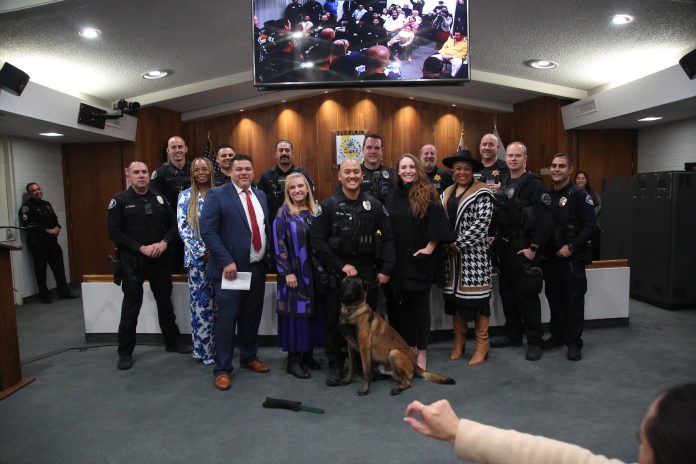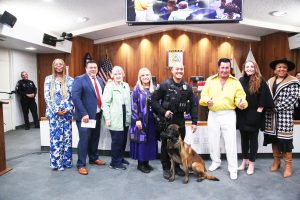
After a year of citizen fundraising and dogged anticipation, the city’s new K-9 unit is finally patrolling the streets of Los Alamitos.

Elvis, the city’s police dog, and his handlers joined Police Chief Michael Claborn at the January meeting to be formally welcomed into service by the Los Alamitos City Council.
Claborn, who was sworn in as Police Chief in January of 2022, had pledged to fully staff the department, then he would consider a K-9 unit.
Now, with the city’s police department fully staffed for the first time in decades, Claborn said Elvis will become a valuable resource for the city.
Sgt. Nestor Rodriguez, who supervises the program, said it has been more than two decades since Los Alamitos PD has had a K-9 unit.
Rodriguez said many reasons contributed to the lack of a K-9 unit for those two decades, including economics, disfavor of the police chief, and liability issues.
Rodriguez, a former handler, has a decade of experience with police dogs and understands the complex program and facilities required to maintain a dog, but says they add much to a department.

(L-R) Council member Trisha Murphy, Mayor Jordon Nefulda, Dayl Salamanca (donor), Mayor Pro-tem Shelley Hasselbrink, Officer Marc Navarro, Elvis, Kenny Brandyberry, donor, Council members Emily Hibard and Tanya Doby.
“Basically, Elvis will be at our disposal for any incident that requires a dog and keeps an officer safe,” he said. “This is what we need.”
The dog “finds the bad guys,” which keeps officers safe.
Moreover, Rodriquez said police dogs can play a tremendous role in community engagement.
“This shows the public that we’re not any different than they are,” he said, and they add to the notion “that we’re doing everything we can to keep them safe and we’re doing as much as we can to safeguard their property.”
In Los Alamitos, just the prospect of “Elvis” created excitement in the community that took on a life of its own.
Rodriguez said citizens have raised half of the approximate $150,000 it will cost to re-establish the program in Los Alamitos.
In addition to specialized housing and training, Elvis has to have a specified diet, rigorous training and of course, the city will need a specially equipped K-9 unit.
“Just the training was $45,000,” said Rodriguez.
Rodriguez said they spoke with Officer Marc Navarro once the city began exploring the program, “who agreed to take on the project.”
He said residents are now raising money to buy more K-9 gear that Elvis will need.
Navarro, who was honored in 2023 by the U.S. Attorney General, confirmed that he has now been trained to become the city’s K-9 officer.
Once the city committed, Rodriguez said they contacted a European police dog breeder, who introduced Navarro to several dogs.
He and the police dog that would later be named Elvis had found each other. Rodriquez said the Belgian Malinois was sent to Germany for formal training.
In the interim, Rodriquez said local business owner and philanthropist, Kenny Brandyberry stepped up and agreed to pay the entire $15,000 cost of the dog…but only if the erstwhile police dog would be named “Elvis.”
That’s how the saga of “Elvis” the police dog began.
While the dog was away for training, his mobile K-9 unit was manufactured, and other provisions were made to properly support the police dog.
Rodriquez said Elvis is now back in the USA, fully trained. One small thing, however, Elvis was trained in Germany so if you hear Officer Navarro commanding him in German, don’t be surprised. Elvis understands German.
Navarro said he and Elvis took their first patrol on Christmas Day. “I’m taking it slow,” he said, introducing Elvis to the people and places in the city.
“He needs to get used to his environment,” said Navarro. Currently, he’s bringing Elvis to the P.D. and city hall, letting Elvis meet people and begin to understand the city.
“And then once I feel that he is comfortable, I will let him go around the station. He seems to be doing fine,” said Navarro.
Navarro said he enjoys patrolling with Elvis. “My fourth kid,” Navarro jokes.
“Seriously, it makes the time go by quicker,” he said, noting that Elvis is good company.
“I talk to him all the time. And I always try to figure out what he’s thinking, you know, just reading cues or his body language,” he said.
“I try to see if he understands what I’m saying to him, or what we’re talking about, you know, of course, it’s difficult since he can’t really talk back to me but I’m getting used to him to the point where I notice different indicators in his body language,” the city’s K-9 officer said.
Other than Rodriguez, he said, there is little K-9 experience to fall back on within the department. Navarro knows he’s breaking new ground.
“I don’t want to say I’m the guinea pig of it, but if I’m setting the standard, you know, and right now I’m just creating legacy at this point. So I’m doing as much as I can; have my own hours to you know, pretty much squirrel away this program and square away the dog and make it work so well.”
Editor’s Note: Cities across the U.S. have long used police dogs for a variety of law enforcement tasks, and since the scientific name of a dog is a canine, the term K-9 quickly became shorthand, or slang, for the scientific term.
